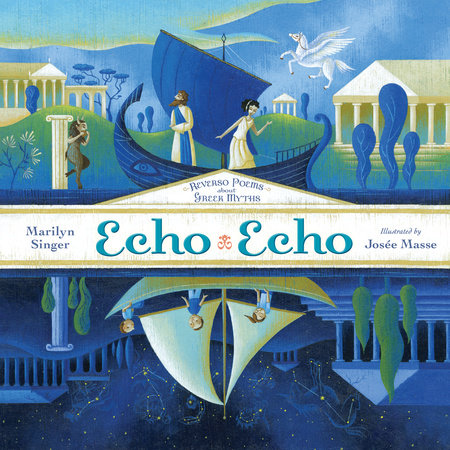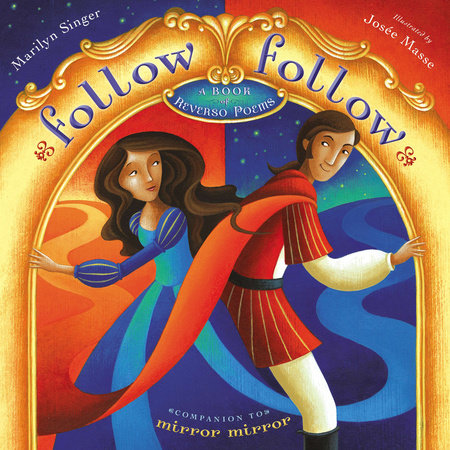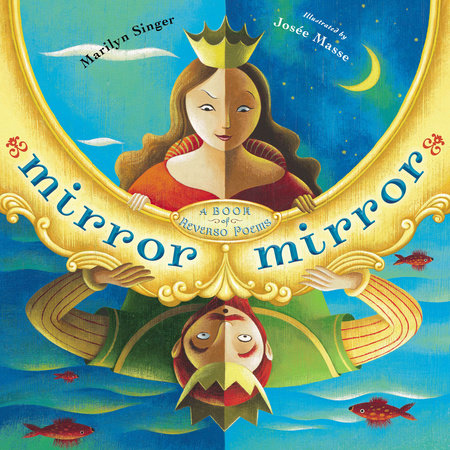Reverso Poetry:
Writing Verse in Reverse
by Marilyn Singer
A doll. A cat. A love of games. A grandma. A fascination with fairy tales, myths, and poetry. What do these things have in common? They are the major ingredients that led to my creating “reversos.”
A reverso is a poem with two halves. In a reverso, the second half reverses the lines from the first half, with changes only in punctuation and capitalization — and it has to say something completely different from the first half (otherwise it becomes what one blogger’s kid called a “same-o.”)
Reading and writing reversos is a good way to make poetry fun. Even kids (and adults) who claim they don’t like poems seem to enjoy these, because it is a form that can be shared — you can read the poems aloud, play the characters, puzzle out who said what and why, or even try to figure out how someone wrote the darn things.
So how did I come to create this poetry form? Let’s start in reverse order, with the last ingredient I listed: a fascination with fairy tales, myths, and poetry. I was a lucky kid in that my family always read to me a lot, and what I liked most were tales, myths, and poems. I loved their magic, images, and wordplay. I loved hearing them spoken aloud, particularly by my Romanian grandmother. Grandma Frieda and I shared a bedroom until I was thirteen — first in our apartment in the Bronx, then in our house on Long Island — and she was a fantastic storyteller. Her stories helped me go to sleep, to dream, and, eventually to write, which I started doing in third grade.
As a child I wrote lots of stuff, particularly poetry. I mostly preferred free verse but eventually became interested in poetic forms. I experimented with triolets, cinquains, villanelles, sonnets, and haikus. I’ve always loved games, and playing with these forms felt very much to me like playing games. It eventually led me to make up my own games — and my own form of poetry.
Now where does the cat come in? I’ve always found dogs and cats inspirational. I’ve written poetry, nonfiction, and fiction featuring canines and felines, yet I never expected that a cat would lead to a new poetry form. One fateful day, I was sitting in my living room and I saw her snuggled in a chair. What came into my head was this:
A cat Incomplete:
without A chair
a chair: without
Incomplete. a cat.
That little poem got me excited. I wondered if I could write more like it … so I did. I gathered up these poems and showed them to an editor. Because a number of the poems were based on fairy tales, she suggested I base the whole collection on fairy tales alone. It was a compelling idea: Fairy tales have a strong narrative and I figured that for these poems I could find two sides to one character, two points in time for a character, or two different characters with opposing points of view. I still wasn’t sure what to call the poems, though. When my wonderful husband, Steve Aronson, described the poems as “reversos,” I knew I finally had a name for them.
And the doll? When I was a kid, my uncle gave me a Rags-to-Riches doll. She had bare feet, and she came dressed in a shawl, a patchwork skirt with a drawstring, and a babushka. When you removed the shawl and pulled down the skirt, presto! She was wearing a golden ball gown. Off came the babushka, and she had on a tiara. All you had to do then was put on her slippers and the transformation was complete. I couldn’t swear to it, but I’m pretty sure that that doll was in the back of my brain when I wrote “Cinderella’s Double Life,” my first fairy tale reverso:
Isn’t life unfair?
Stuck in a corner,
while they’re waiting for a chance
with the prince,
dancing waltz after waltz
at the ball,
I’ll be shining
these shoes
till the clock strikes midnight.
Till the clock strikes midnight,
these shoes!
I’ll be shining
at the ball,
dancing waltz after waltz
with the prince,
while they’re waiting for a chance,
stuck in a corner.
Isn’t life unfair?
“Cinderella’s Double Life” represents the same character at two points in time; it was included it in my fairy tale collection, which became the book Mirror Mirror. In Follow Follow and Echo Echo, my second and third books of reversos, I continued to play with the poetic form exploring more fairy tales and Greek myths. I created some poems that revealed two entirely different points of view for one character, and others that reflected the thoughts of two different characters.
To be honest, I don’t know how I actually write reversos. I’m not trying to be secretive — it’s really a bit of a mystery to me! I know that I can’t do it all the time; I have to get into a certain type of games-playing frame of mind to write these poems.
But if you and your kids want to try writing reversos at home, I can offer a few tips:
- Find a story, subject, or character with two sides.
- Start with a few lines that can be flipped so they make sense in reverse.
- Select phrases that can be turned into questions and interjections.
- Use a lot of participles, infinitives, and single word sentences.
- The reversos have changes only in punctuation and capitalization, so get to know punctuation — how can you use a comma, period, dash, colon, semi-colon, etc.?
- Write the poem on the computer so you can move the lines around until they make sense.
- Don’t get discouraged — reversos are hard to write. Play and have fun!
Do you and your children ever read or write poems together? Let us know in the comments section below!
-
Follow Follow
Also available from:Mirror Mirror
Also available from:



